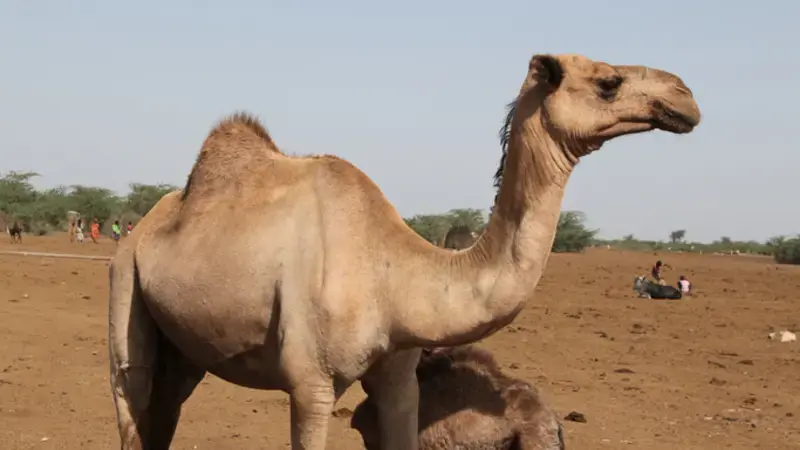Camel’s Milk: a New Tool to Eradicate Parasites?
Published Date
October 06, 2016

Camel with calf in Afar, Ethiopia (photo credit: ILRI)
A recently published study by the National Veterinary School of Sidi Thabet, Tunisia and ICARDA suggests that camel’s milk offers a practical and sustainable resource to tackle widespread gastro-intestinal sheep worms in low input production systems.
Camel milk offers a sustainable and highly effective means of controlling parasite populations in livestock, according to research undertaken by scientists from Tunisia and ICARDA. In a breakthrough study, conducted on one of the most virulent gastro-intestinal sheep parasites, results demonstrate that camel’s milk has the potential to eradicate sheep worms, and thereby deliver significant livelihood gains to livestock producers.
Parasites are a major health and welfare problem for small ruminants, causing death or severely limiting productivity levels in terms of growth and reproduction. Evidence suggests that many are developing resistance to the most common control tool: the repeated use of synthetic anti-parasite molecules.
In response, there has been growing interest in the use of natural products. “Natural products are an alternative source of bio-active compounds to control viral, bacterial and parasitic infections,” says Dr. Hafidh Akkari, a member of the research team in Tunisia. “Nutritional pharmacology is an important new research area for clean and sustainable livestock enterprises.”
Milk is one option that has been considered since it is has anti-parasitic properties and is also renewable, environmentally friendly, quickly degradable, easily accessible, and cost effective
The benefits of camel milk
Despite the prevalence and growing numbers of camels throughout Africa, Asia and the Middle East, there have been no previous studies on the efficacy of using camel’s milk to fight parasitic infections. This is unfortunate given its many nutritional benefits: a high concentration of insulin and protective proteins; the presence of important minerals, such as sodium, potassium, iron, copper, zinc and magnesium; and high concentrations of vitamins A, B-2, C and E.
Controlling parasites
In addition to a detailed chemical analysis of the camel milk, the research team used two main tests to investigate the in vitro efficacy of camel milk against a common type of gastrointestinal parasite, Haemonchus contortus. This blood-sucking parasite of the sheep stomach can cause severe anemia and productivity losses; acute infestations and high worm burdens may even cause death in lambs.
The in vitro study tested the effect of camel milk on the hatching ability of parasite eggs and the motility and viability of adult worms. Results were compared to milk from cows, ewes and goats, and a reference chemical drug, albendazole.
Chemical analysis revealed that camel’s milk had a higher concentration of lactoferrin, a protective protein with known anti-bacterial, anti-viral, anti-fungal, anti-inflammatory, anti-allergic, and anti-cancerous properties. It also had a high concentration of Vitamin C, an important anti-oxidant and immune-stimulant vitamin.
The effect of camel milk on egg hatching and adult parasite populations was impressive: camel’s milk was the only milk-type to have an inhibitory effect on egg hatching, and it caused significant paralysis or death of adult worms at different post-treatment intervals, even at low concentrations.
“This study is the first to conclusively show that camel’s milk could potentially help control the most important parasite affecting sheep,” says Dr. Mourad Rekik, a senior small ruminant production scientist at ICARDA, who collaborated in the study. “Given its in vivo effect and bioactive molecules, we believe that camel milk represents an accessible, renewable and cost-effective alternative to control parasites. Harnessed properly, it provides an opportunity to boost livestock productivity and raise rural incomes.”
The study entitled ‘First Report of the In Vitro Nematicidal Effects of Camel Milk’ – was recently published by the scientific journal 'Veterinary Parasitology' and can be accessed here: http://www.sciencedirect.com/science/article/pii/S0304401716303648
